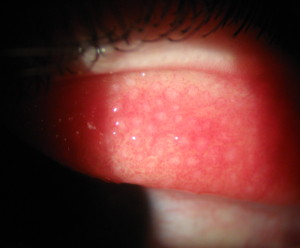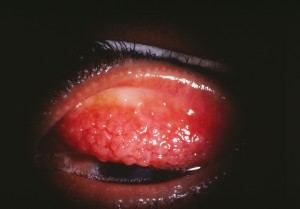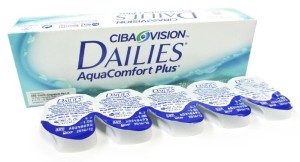Contact Lens wearers of the world, meet one of the greatest enemies of successful contact lens wear:
Giant Papillary Conjunctivitis or GPC.
“My contact lenses wear out REALLY fast, I am constantly changing them!”
“I just can’t wear the contacts very long, they’re always moving on my eye.”
“I’m getting this weird stringy, white goop when I wear my contacts.”
What is Giant Papillary Conjunctivitis?
 Giant Papillary Conjunctivitis, or GPC as it is commonly known, is an inflammatory condition involving the conjunctiva of the human eye.
Giant Papillary Conjunctivitis, or GPC as it is commonly known, is an inflammatory condition involving the conjunctiva of the human eye.
The conjunctiva is the thin slippy tissue that covers the front of the eyes as well as the inside of the eyelid. The hallmark of this condition are small (and sometimes GIANT!) bumps called papillae that form on the underside of the upper eyelid.
This is very chronic condition and can range from mild, to moderate (such as our patient pictured left), to very, VERY severe (If you are squeamish, DO NOT CLICK!).
Holy Crap! What Causes These Bumps?
At its core, GPC is an allergic condition and occurs almost exclusively in contact lens wearers (90 plus percent). It can also rear its ugly head with patients (like myself) who have very severe allergies – and in the Ohio River Valley, there are lots of us!
“It is estimated that up to 35% of extended wear contact lens wearers with develop symptomatic Giant Papillary Conjunctivitis.”
With contact lens wearers every individual is different. These bumps frequently form with certain types or brands of contact lenses, from the chemicals in contact lens cleaning solutions, or from overwear/abuse of contact lenses.
This is essentially a mechanical problem.
The brain is physiologically wired to blink the eyes every 10-12 seconds. Every time a blink occurs the underside of the lid rubs against the contact lens. Deposits, chemicals, and/or allergens on the contact lenses will begin to irritate the conjunctiva of the upper eyelid. With each blink these inflamed papillae begin to form, multiply, and expand making the symptoms worse and worse.
Why do these “bumps” cause me problems?
 Think of these papillae bumps like the grit on sandpaper.
Think of these papillae bumps like the grit on sandpaper.
- With each blink, these ‘sandpapery’ bumps rub, push and pull the lens around making it uncomfortable to wear.
- The bumps also poorly wet the lens making deposits form quicker. This results in the need to change your contacts far more frequently.
- Finally, the areas between the bumps allow mucus to form leading to an irritating, stringy, and often blurring mucus that coats the eye.
Not to mention that as the papillae bumps multiply and grow, the rubbing on the contact lenses increases making the symptoms worse and the bumps bigger – a death spiral for contact lens wear.
What do we do about it!
 Well, the problem here is that when the papillae are mild, the symptoms usually get shrugged off or put up with for months or even years.
Well, the problem here is that when the papillae are mild, the symptoms usually get shrugged off or put up with for months or even years.
Once the symptoms are bad enough that the contact wearer come in because the contacts “aren’t working”, the Giant Papillary Conjunctivitis is usually quite ‘ground in,’ severe and chronic.
If this condition IS caught early, a simple change to Daily Disposable lenses is usually sufficient. Daily Disposable lenses are replaced every day which means there is no time for deposits or allergens to attach to the lenses. Additionally, there is no solutions needed for Daily Disposable lenses which removes a lot of cleaners and chemicals that contribute to the papillae bumps.
For severe problems unfortunately, there is NO simple solution and the treatment usually consists of several steps.
- First step is discontinuing ALL contact lens wear. It doesn’t matter what lens we put on your eye at this point, it’s going to get manhandled by those BIG bumps!
- Since this is an inherent inflammatory reaction, we will start you on steroid eye drops for a period of weeks to months. Since this is a chronic condition, it often takes a long time to reduce these bumps to a level acceptable for comfortable contact lens wear.
- Once the Giant Papillary Conjunctivitis is under control, we will fit you will Daily Disposable lenses to keep this from happening again.
Other treatment options for this condition included discontinuing contact lenses all together or exploring the possibility of a surgical solution to refractive error through LASIK surgery.
If you are a contact lens wearer and have noticed these symptoms in your eyes. Please consider scheduling an evaluation with your eye care provided. With Giant Papillary Conjunctivitis, an ounce of prevention is worth a pound of cure.
If you have any questions about this topic or any others, please contact me at [email protected]
Take care of those eyeballs!
- Nick Wolf, OD


